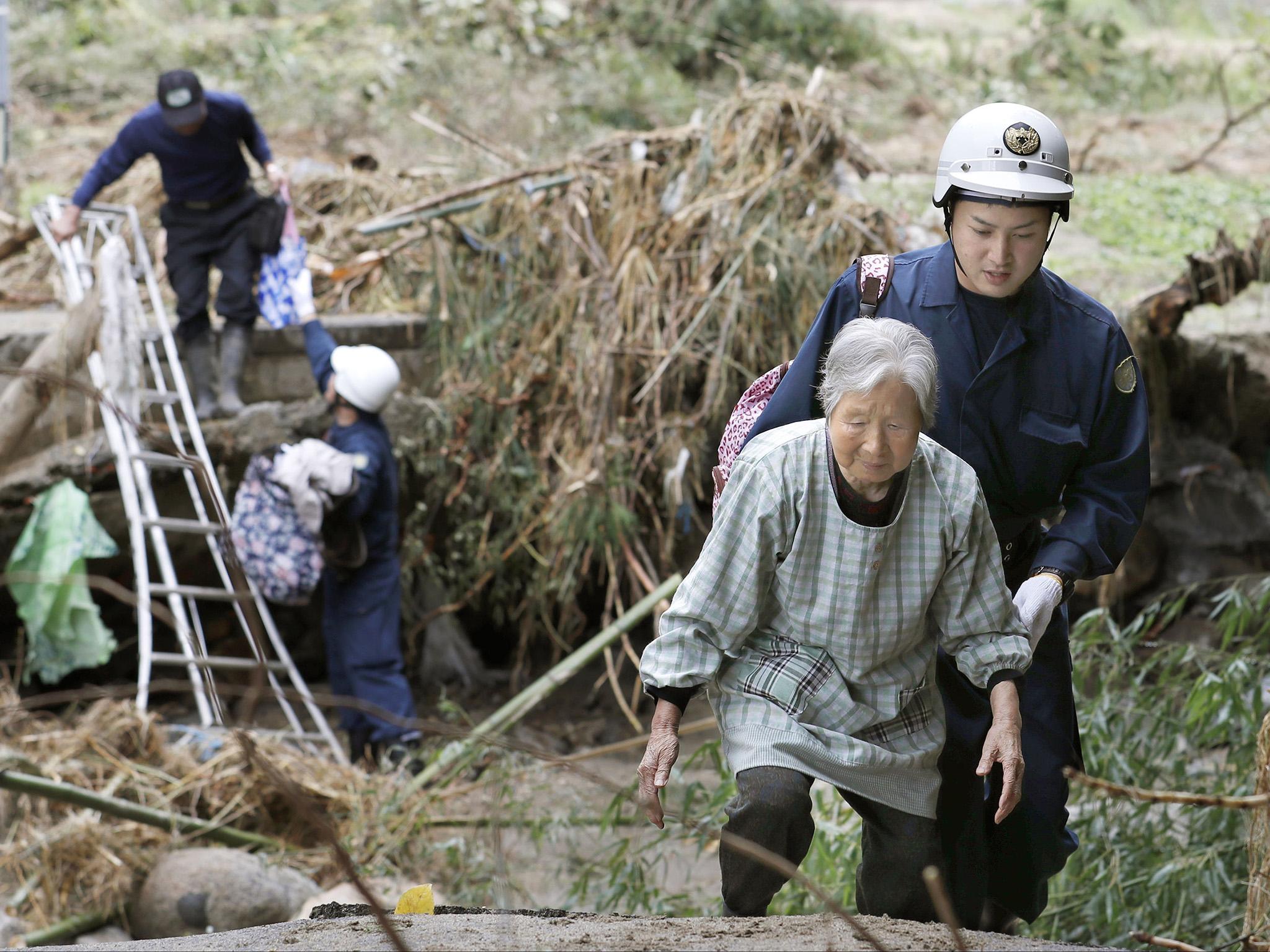‘Everything is gone’: Japan left reeling from worst storm in decades
Typhoon Hagibis left at least 78 dead. But Japan is sadly well accustomed to responding to natural disasters, Samuel Lovett reports


By dawn’s break, after a night of lashing rain and violent winds, the full scale of destruction was laid bare. For Koriyama, an industrial hub in Fukushima Prefecture, the flooding had been extensive.
In the east of the city, whole neighbourhoods were left submerged. All that could be seen, as rescuers began their recovery efforts last weekend, were the rooftops – islands of grey and iron-brown beneath a subdued sky.
Typhoon Hagibis, one of the strongest storms to hit in decades, has left its mark on Japan. Five lives were lost in Koriyama. In the Suimoncho neighbourhood, a compact network of worn, wooden homes that sits on the city’s river banks, one of their own was among that count.
The floodwater had come quickly in these parts, rising to chest height in little more than an hour after a major levee was broken.
“There’s never been this much damage before,” says Moe Kaneda, a teacher in the city centre. “This is the first time ever.”
Fukushima, which suffered immensely with the horrors of the 2011 earthquake, was one of the hardest-hit prefectures in Japan. Of the 78 people so far confirmed as dead in the wake of Hagibis, with nine others still missing, 25 are thought to have come from the northeast.
Many of those were killed in the floods. At least 14 levees burst along the Abukuma River, which meanders through a number of cities in the prefecture, including Koriyama, spinning into motion the chaos that locals are now attempting to recover from.
In Suimoncho, the narrow streets are lined with rubbish and sodden debris days after the storm’s arrival. Mattresses stained brown with flood water are stacked high in the street. Broken TVs are coated in dust. A pair of football boots are left to dry in the warm sun. Homes stand empty and bare, skeletal-like, stripped of their possessions as residents, clad in white overhauls, salvage what they can. As of Wednesday afternoon, many elderly remained in local evacuation centres – municipal buildings, sports halls, high schools – unable to clean up their homes.
For Chiko and her family, there’s a long way to go before any sense of normality returns. Their house, close to the foot of one the river’s levees, has been devastated.
“I think it’ll take a month to sort,” she says, a wheelbarrow to hand and with a mask covering her face. “The bottom floor is completely ruined. Everything is gone.”
It’s the same story for those homes up and down the country that were engulfed by the floodwaters. NHK, Japan’s national broadcaster, reported this week that 13,000 houses were submerged and more than 1,100 at least partly destroyed. Meanwhile, about 12,000 homes are still without electricity or have no running water. It’s unclear how long it will take for utilities to restore full-working service.
The worry is what comes next for Koriyama, Fukushima and similar areas that are continuing to bear the brunt of Japan’s natural disasters.

While the likes of central Tokyo woke to sharp sunshine last weekend, unharmed and largely unscathed by Hagibis, the same cannot be said for those regions where infrastructure offers insufficient resistance to the fury brought by typhoons, earthquakes and tsunamis.
In the capital, subterranean surge chambers, some the size of cathedrals and two football fields long, protect the city above during heavy storms and the torrential downpours they generate. In Koriyama, the main line of defence is banks of earth three metres high.
Although Hagibis was unprecedented in scale and ferocity – weather officials said some places that flooded received up to 40 per cent of their annual rainfall in just two days – many are fearful that, under the effects of global warming, a similar-sized storm will return in the near future.
“It could be climate change,” says Moe. “This is the first time it’s been very bad but after a year or some time we could get hit by another big typhoon because of warming.”
Given the area’s recent history, the prospect of more natural disasters, or an increase in their frequency, sends a shiver down the spine of those living here.
People came together after the earthquake . . . We will do the same now
As with the wider country, Fukushima’s economy was decimated by the 2011 Tohoku earthquake and tsunami. The region also had to contend with the nuclear fallout from the damaged Daiichi power plant as radiation leakage made its way into water supplies, milk and vegetables.
Regrowth was hindered by staggering financial costs – in excess of $250bn (£192bn) for Japan as a whole – and high relocation rates, which saw local populations shrink and shoot upwards in age. Around 10,000 residents left Koriyama in the aftermath of the disaster, while villages up and down the prefecture were hit hard by mass exoduses.
Some remain unconvinced that Fukushima has fully recovered, despite the insistence of municipal authorities that this is the case. And now, the prefecture is facing yet another expensive clean-up. At this stage, who knows how much of a setback Hagibis will prove to be for the region.
“Economic impact in disasters can quickly cascade through different sectors of the economy,” says Hiba Baroud, a professor of civil and environmental engineering at Vanderbilt University. “Production can be affected either by direct impact from the disaster or through interdependent effects resulting from disruptions in the supply chain.
“Local and national authorities need to account for all these aspects in assessing the damage to identify the best recovery strategy for the city.”
Indeed, the government has already said it plans to designate Typhoon Hagibis as a “severe natural disaster” to free up more subsidies for reconstruction.
Some will feel, though, that the “best recovery strategy” is simply soldiering on. Japanese resilience is given no greater showing than in the face of natural-spun adversity.
Although the nation is by no means immune to the pain, suffering and loss that comes with these disasters, there seems to be an inherent drive among the people to dig in, to carry on, to serve their duty in times of difficulty – of which there have been many over the years.
“I think that’s a really strong part of Japanese society in general,” says Joost Kralt, a coordinator for international relations at Koriyama City Hall. “They really go with the punches.”
Having pulled through the agony of 2011 and the harsh years that followed, the people of Fukushima will likely strive to do so again in the face of this latest crisis. “People came together after the earthquake,” says Moe, wearing a smile of defiance. “We will do the same now.”
Join our commenting forum
Join thought-provoking conversations, follow other Independent readers and see their replies
Comments
Bookmark popover
Removed from bookmarks